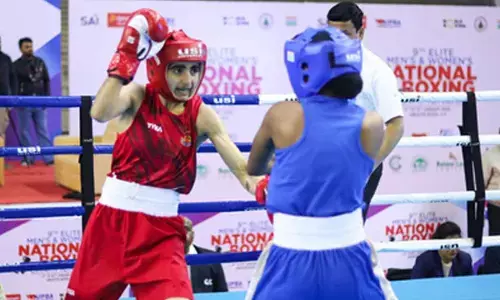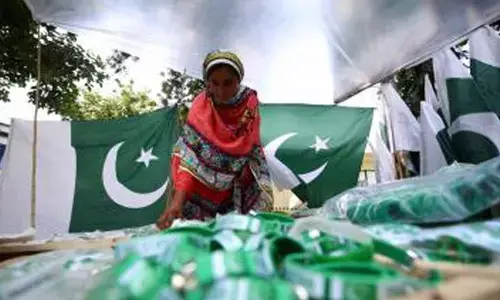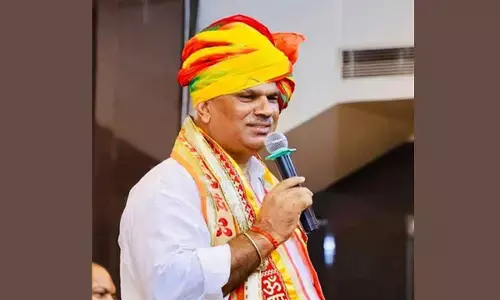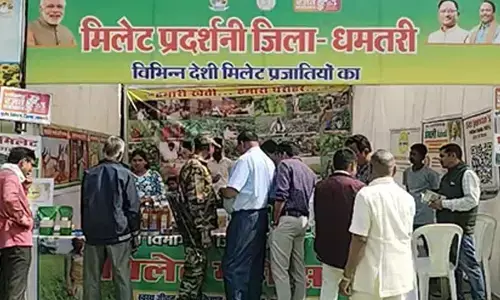Jaya Jaya Hey Mahishasura Mardini Ramya Kapardini Shaila Suthe
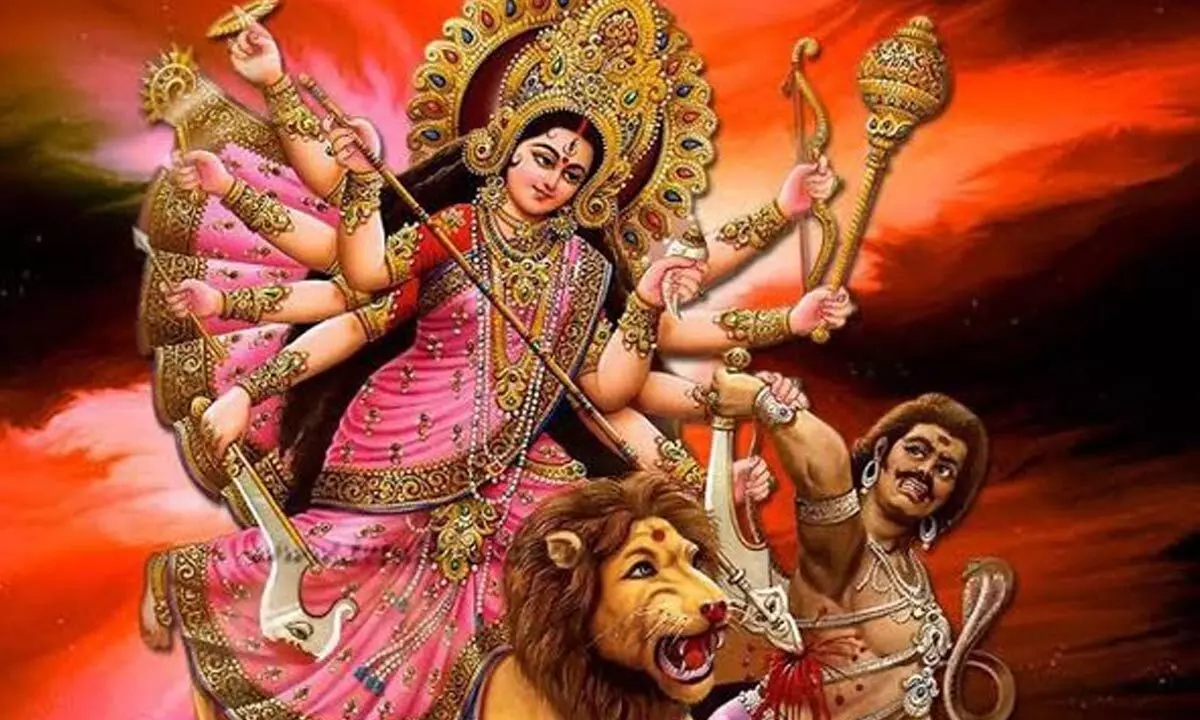
Hinduism has many Gods and Goddesses but most Hindu traditions claim there is only one Goddess or Devi with many different manifestations.
Hinduism has many Gods and Goddesses but most Hindu traditions claim there is only one Goddess or Devi with many different manifestations. She is often referred to as Shakti meaning all Powerful and full of Cosmic Energy. Sharad Navratri is a sacred Hindu festival dedicated to Goddess Durga and is a time of profound devotion, fasting and prayer. All the nine days and Dashami, the 10th day are celebrated with great religious fervor, and piety across the country.
During Navratri devotees engage in various rituals, reflecting their devotion and reverence for the goddess. The devotion, the holiness, the zeal for the Devi is inexplicable that is traditionally there in all Hindu families for centuries. With the changes in the generations and windows opened to the world the vibrant evenings come alive with the lively Garba and Dandiya Raas dances, where people dressed in colourful attire celebrate the joy of life with immense enthusiasm, pomp and show. The spirit and ardour remain the same through-out the festival. We children of 60s and 70s had no idea of all these, but the spirit, the moral values and the ethos remain the same till day. After the morning puja, and festive lunch, most children in the evening, from the colony, used to gather around my grand-mother, well read and well versed, lady in the Hindu scriptures. Every year she repeated the religious importance of Adi Parashakti in our lives and why she is more powerful than any of the Gods and Goddesses we worship. After listening to so many years it became part and parcel of our survival and every Navratri, I relive the entire cycle of my grandma’s narration.
The scripture associated with Navratri is Devi Mahatmyam, also known as ‘Devi Saptasati’ or ‘Chandi Path’. It’s the Hindu religious text which describes the victory of Goddess Durga over the demon Mahishasura. Devi Mahatmyam is the part of Markandeya Purana which was written by the sage Markandeya, venerated within all main stream Hindu traditions.
Goddess Durga is worshipped all nine days of Nav Ratri, as one of the key aspects of the mother Goddess known as Devi. She is the primordial goddess or the creator of the universe. She is the supreme energy from where all other beings branch. Durga Devi is associated with protection, motherhood and strength and in some she is also associated with destruction and war. She is one of the most widely worshipped and favoured divinities within the Hindu religion. She was originally created to defeat the demon Mahishasura, (Mahishasura Mardini), as only a woman could defeat him. She is often depicted as beautiful woman with many arms, each wielding weapons while being mounted on a lion. She is considered as one of the most powerful and protective deities. Durga was not incarnated to have a child instead was created to slay the buffalo demon who was a cousin of the Gods. He was granted immortality by Lord Brahma, the Creator with one catch- he could be killed by a woman. Underestimating the power of a woman the demon became reckless and all powerful with his newly acquired powers. He along with the other asuras under the garb of immortality, attacked all Gods. The Gods Brahma, Vishnu, and Maheshwar decided to combine their energies to defeat the demon king, combining in Goddess Durga, the incarnation of Devi who was an all-powerful woman. When Mahadevi appears as Durga, she is seen as an epitome of power, a beautiful Indian woman with many arms holding weapons and other symbols. Her 10 arms are to protect her followers from 8 corners of the earth, as well as the earth and the sky, that is, the ‘Brahmandam’. She is a fierce and powerful warrior and sends shivers down the enemy spine. The various powerful Gods equipped the new Goddess Durga with lots of divine weapons and symbols before she went into battle with the demon. It proved quite difficult for the Goddess as, the, demon Mahishasura kept changing his form to confuse her. However, when he finally turned into buffalo Maa Durga vanquished him after battling for nine days and nine nights and emerged victorious. This victory symbolizes the triumph of good over evil. Let us know the special messages each weapon of Goddess Durga conveys.
Khanda, the sword gifted by Lord Ganesha signifies intellect and wisdom and the power to discern right from wrong. The Trident, the Trishul, the three- headed sharp weapon given by Lord Shiva represents the three gunas of humankind, tamas, rajas, and sattva. The Goddess is considered to be beyond the limits of time and hence she rules it. The Sudarshan Chakra given by Maha Vishnu symbolizes the center of creation. It also urges humans to exhibit loyalty, love and devotion to Goddess Durga. The Vajra given by Indra symbolizes the firmness of spirit and character, determination and supreme power. When you pray to Maa Durga, she will help shatter problems encountered in life without losing confidence. Vayu gave her bow and arrow used by gods and kings alike from times immemorial. This combination of potential and kinetic powers symbolizes energy and suggests that a person should have the ability to attain his or her goals independently. Bharji, the spear/javelin gifted by God Agni represents pure fiery power. It tells humans to recognize hidden power in them to overcome all the obstacles in life. Varun, the God of sea gave her his Shankh, the Conch, symbol of primordial sound of creation, Aum. It is believed that the sound Ohm or Aum originated from Shankh, when the Universe was created. Hence it has the power to destroy all the negative energy. Lotus is the symbol of Brahma that represents wisdom, Devotion and surrender and let go off the outcome. The Club or Axe given by Vishwakarma will kill the evil and choke it to death. We need to kill the evil within us too, fearlessly. The tenth hand of Durga is usually shown empty in blessing, or holding the Trishul killing the demon. It is actually supposed to be holding a snake given by Lord Shiva. It symbolizes consciousness and masculine energy of Shiva. The weapons of Goddess Durga teach us the qualities we should possess to be powerful and successful. Her fight with the demon is just not removing evil but sets an example for upcoming generations and tells them that we can achieve anything in life with deep devotion.
Just as Maa Durga’s arms and their possessions have a distinct symbolism in the same way each day of Sharad Navratri has a distinctive colour and Maa Durga is worshipped as Nav Durga on all nine days till Navami. Goddess Shaila Putri, is worshipped on the first day of Navratri. She is dressed in blue attire. The colour symbolizes the abundance of health, wealth and power. On the second day Devi Brahmacharini is all in white, symbolizing knowledge and learning. Red is the colour of the third day of Navratri. Goddess Chandra ghanta is worshipped, symbolizing new beginning, growth and fertility. Royal Blue stands for abundance and serenity. This vibrant colour is used to celebrate the goodness of Maa Kush Manda symbolizing wisdom and dignity that comes with experience and age. Yellow that symbolizes warmth, fire and energy is the colour for the 5th day of Navratri and Maa Skanda Mata is worshipped on this day. The colour also conveys the message of positivity. The colour of the sixth day of Navratri is green dedicated to Goddess Katyayini. It evokes ideas of plenty and fertility. The seventh day of Navratri is being celebrated with the colour grey. This sober and elegant hue is used to celebrate the goodness of Goddess Kala Ratri. Maha Gauri is worshipped on the eighth day and is regarded for forgiving her devotees sins. Purple flowers are offered to the Goddess who symbolizes tranquility, serenity and beauty. The last day of Navratri is celebrated as Mahar Navami puja, the ninth manifestation of Goddess adores vivid hues, particularly peacock green. This colour stands for Peace, Love and Kindness. The Goddess in all her nine manifestations promotes the values of purity, self- discipline and charity.
Navratri ends with Vijayadashami celebration considered as the most auspicious day. In North India Dussehra is celebrated on the 10th day after Navratri, marks Lord Rama’s victory over the 10 headed demon king Ravana. Lord Rama worshipped goddess Durga for nine days seeking her blessings before defeating Ravana. People enact the battle that took place between Ram and Ravana known as Ram Leela for ten days. Giant sized effigies of the three, principle, demons like Ravana, Meghnad and Kumbhakarna are made. The man who plays the role of Rama shoots the fiery arrows at the effigies, filled with fire crackers, to burn them down. Across the country the theme of good prevailing over evil resonates, creating a unifying thread in the diverse ways of Navratri is observed. A lesser-known fact- about, Dussehra is that it is also celebrated as the home coming of the Pandavas from exile. After the final year of their exile was over, it was on the holiday of Vijayadashami that they retrieved their weapons and worshipped both weapons, the Ayudha Puja, which is a practice that continues in some regions of South, and Shami tree, proclaimed their true identities and defeated Kauravas. The importance of Shami tree has been cited in all the sacred scriptures. It is the State Tree of Telangana state. On the Vijayadashami day leaves of Shami tree are exchanged among friends and relatives as gold. They wish them success in every aspect of life.
Fasting, meditation, prayers and other spiritual practices performed during this period gives rest to body and mind and connects us with our spirit. Getting in touch with our spirit invokes positive qualities within us and destroys laziness, pride, obsession, cravings and aversions. When these negative emotions are destroyed, we emerge and transcend ourselves totally into a stranger.








